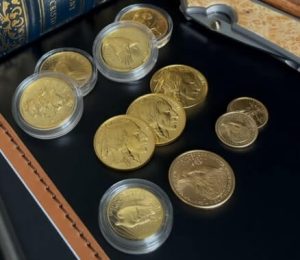Understanding the Basics of Gold IRAs
In the ever-changing world of finance, spreading out your retirement investments isn’t just smart—it’s essential. Increasingly, investors are turning to Gold IRAs as a reliable and proven method to protect their assets while benefiting from the lasting worth of precious metals.
No matter if you’re just starting out or have years of experience, this detailed guide will cover everything you need to know about Gold IRAs, empowering you to make confident choices for a stronger financial tomorrow.

What is a Gold IRA?
A Gold Individual Retirement Account (IRA) is a self-directed retirement account that allows you to invest in physical precious metals like gold, silver, platinum, and palladium, instead of traditional paper assets like stocks and bonds. This investment vehicle offers a hedge against economic uncertainties and inflation, making it an attractive option for those looking to diversify their retirement portfolios.
Why Consider a Gold IRA?
1. Wealth Preservation
One of the primary reasons individuals opt for Gold IRAs is wealth preservation. Gold has maintained its value for centuries and is often seen as a safe haven asset during times of economic turbulence. Its tangible nature provides a sense of security, especially when compared to the volatile nature of traditional investments.
2. Diversification
Diversification is a fundamental principle of investment. By adding precious metals to your retirement portfolio, you reduce risk by not having all your assets tied to the performance of a single asset class. When stocks and bonds are down, precious metals often see an increase in value.
3. Inflation Hedge
Gold has historically served as a hedge against inflation. When the purchasing power of fiat currencies like the U.S. dollar diminishes due to inflation, the intrinsic value of gold tends to rise. Holding gold in your IRA can help protect your retirement savings from the erosive effects of inflation.
Getting Started with a Gold IRA
Investors that are just starting to learn about gold IRAs will often wonder how much money do you need to start a gold IRA? This is a very important question. Most companies require a minimum of $5,000 to get started, but that is a really small amount for a retirement account. The more reputable companies in this space require a minimum of $25,000 – $50,000 to open an account.
Now keep reading because these are the basics you need to get started.
1. Eligibility
To open a Gold IRA, you must meet certain eligibility criteria. You need to be under the age of 70½ and have earned income. The maximum annual contribution limits are determined by the IRS, so it’s essential to stay within these limits to maintain your account’s tax advantages.
2. Choose a Custodian
A Gold IRA must be held by an IRS-approved custodian or trustee. This is a critical step in the process. Custodians are responsible for managing your account and ensuring compliance with IRS regulations. When selecting a custodian, consider their reputation, fees, and the level of customer service they provide.
3. Rollover or Transfer
If you already have an existing IRA or 401(k), you can choose to roll over or transfer a portion of those funds into a Gold IRA without incurring penalties or taxes. This is a straightforward process that allows you to preserve the tax-advantaged status of your retirement savings while diversifying into precious metals.
4. Selecting Precious Metals
Once your Gold IRA is established, you’ll need to choose the types of precious metals to include in your portfolio. The IRS has strict guidelines on the purity and types of metals that are permissible. Typically, gold and silver coins and bars meeting specific criteria are allowed. Your custodian can provide you with a list of approved metals.
Storage and Security
1. IRS-Approved Depository
Precious metals held in a Gold IRA must be stored in an IRS-approved depository. These facilities are equipped with advanced security measures to protect your assets. They are often located in secure, non-bank vaults, providing an extra layer of protection for your investment.
2. Insurance
Reputable depositories also offer insurance coverage on the precious metals they store. This ensures that your investment remains protected in the unlikely event of theft, damage, or loss.
Tax Considerations
1. Tax Benefits
If you are interested in the different investment types of gold and IRA tax rules, this part is for you. One of the key advantages of a Gold IRA is the potential for tax benefits. Your contributions may be tax-deductible, and your investment grows tax-deferred. Additionally, when you reach the age of retirement and start taking distributions, certain withdrawals may be tax-free.
2. IRS Rules and Regulations
It’s crucial to stay informed about IRS rules and regulations regarding Gold IRAs to avoid any penalties or disqualifications. For example, you are not allowed to take physical possession of the gold in your Gold IRA until you reach the age of 59½.
Fees and Costs
It’s important to be aware of the fees associated with a Gold IRA, as they can vary depending on the custodian and the services they provide. Common fees include:
- Annual maintenance fees
- Storage fees
- Purchase and sale fees
- Miscellaneous administrative charges
Before opening a Gold IRA, carefully review the fee structure with your chosen custodian to ensure transparency and minimize costs.
In this Gold IRA Beginners Guide, we’ve covered the fundamental concepts of Gold IRAs, including their purpose, eligibility requirements, and the steps to get started. We’ve also explored the importance of choosing a reputable custodian, the types of precious metals allowed, and the critical aspect of storage and security.
In the coming section of this guide, we will delve deeper into the investment strategies for Gold IRAs, provide tips for selecting the right precious metals, and offer insights into managing and optimizing your Gold IRA portfolio. Whether you’re considering diversifying your retirement investments or safeguarding your wealth against economic uncertainties, a Gold IRA is a compelling option worth exploring. Stay tuned for the continuation of this guide, where we’ll provide you with even more valuable information to help you make informed decisions for your financial future.
How to Find a Trustworthy Bullion Dealer
Finding a trustworthy bullion dealer is essential when considering investments in precious metals like gold and silver. To ensure the reliability and integrity of a bullion dealer, start by conducting thorough research. Look for established dealers with a proven track record and a good reputation within the precious metals community.
Check for any relevant industry certifications or affiliations, such as membership in respected organizations like the Professional Numismatists Guild (PNG) or the American Numismatic Association (ANA) for tips on locating a quality bullion dealer. Customer reviews and testimonials can also provide valuable insights into the dealer’s reputation for transparency, fair pricing, and customer satisfaction.
Additionally, inquire about the source and authenticity of their bullion products, and make sure they adhere to industry standards for quality and purity. Lastly, compare pricing and fees among different dealers to ensure you are getting fair value for your investments.
Maximizing Your Gold IRA Investment
Welcome back to the second part of our Gold IRA Beginners Guide. In this section, we will delve deeper into the world of Gold IRAs, providing you with valuable insights on how to maximize your investment, tips for selecting the right precious metals, and guidance on managing your portfolio. Additionally, we’ve included a comprehensive FAQ section to address common queries about Gold IRAs.
Investment Strategies for Gold IRAs
1. Diversification
Diversification is a fundamental strategy in investment. A well-balanced Gold IRA portfolio typically includes a mix of different precious metals, such as gold, silver, platinum, and palladium. Diversifying your holdings can help mitigate risk and ensure that your investments perform well under various economic conditions.
2. Dollar-Cost Averaging
Dollar-cost averaging is a disciplined approach to investing in precious metals. Instead of making a lump-sum purchase, you invest a fixed amount of money at regular intervals. This strategy allows you to buy more when prices are low and less when prices are high, potentially reducing the overall cost of your investments over time.
3. Rebalancing
Over time, the value of your Gold IRA holdings may shift due to market fluctuations. Periodically review and rebalance your portfolio to maintain your desired asset allocation. This ensures that your investments align with your long-term financial goals.
Selecting the Right Precious Metals
1. Gold
Gold is the most popular choice for Gold IRAs due to its historical stability and universal appeal. You can invest in gold coins or bars, with American Eagle and Canadian Maple Leaf coins being among the most common choices.
2. Silver
Silver is another popular choice for diversifying your Gold IRA. It tends to have a higher level of price volatility compared to gold, making it attractive for potential short-term gains.
3. Platinum and Palladium
Platinum and palladium are rarer precious metals with unique properties. They are often used in industrial applications, which can influence their market dynamics. Consider these metals as potential additions to your Gold IRA to enhance diversification.
Managing Your Gold IRA Portfolio
1. Regular Review
Keep a close eye on your Gold IRA portfolio. Monitor market trends, economic news, and geopolitical developments that can impact the value of your precious metals. Regular reviews can help you make informed decisions about buying or selling.
2. Consult with a Financial Advisor
Consider seeking advice from a financial advisor who specializes in precious metals and retirement accounts. They can provide valuable insights and help you align your Gold IRA with your broader financial plan.
3. Stay Informed About Tax Implications
Understanding the tax implications of your Gold IRA is crucial. Be aware of the rules regarding required minimum distributions (RMDs) once you reach the age of 72, as well as any potential tax consequences of selling precious metals from your IRA.
Frequently Asked Questions (FAQ)
Q1: Can I store the gold from my Gold IRA at home? A1: No, IRS regulations prohibit the physical possession of precious metals from your Gold IRA until you reach the age of 59½. Until then, your metals must be stored in an IRS-approved depository.
Q2: Are there penalties for early withdrawals from a Gold IRA? A2: Yes, if you withdraw from your Gold IRA before the age of 59½, you may incur early withdrawal penalties, in addition to regular income taxes on the distribution amount.
Q3: How do I choose an IRS-approved custodian for my Gold IRA? A3: Research custodians carefully, considering factors such as reputation, fees, and customer service. Ensure they are IRS-approved and have experience managing Gold IRAs.
Q4: Can I transfer an existing IRA or 401(k) into a Gold IRA? A4: Yes, you can transfer or roll over funds from an existing IRA or 401(k) into a Gold IRA without incurring penalties or taxes.
Q5: What is the role of a custodian in a Gold IRA? A5: The custodian is responsible for managing your Gold IRA account, ensuring IRS compliance, and facilitating transactions on your behalf.
Conclusion
We hope this comprehensive Gold IRA Beginners Guide has provided you with a solid foundation for understanding the intricacies of Gold IRAs. From the basics of getting started to advanced strategies for maximizing your investments, a Gold IRA offers a valuable addition to your retirement portfolio. Remember to stay informed, diversify your holdings, and seek expert advice when needed to make the most of your Gold IRA investment. Your financial future deserves careful planning and consideration, and a Gold IRA can be an essential part of that strategy.
Be sure to read our related article: How Much of Your Retirement Should be in Gold and Silver?
